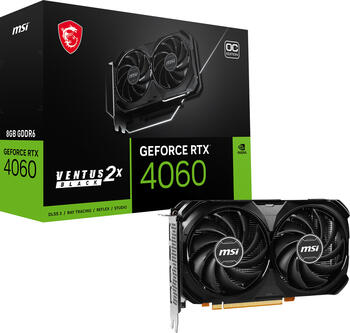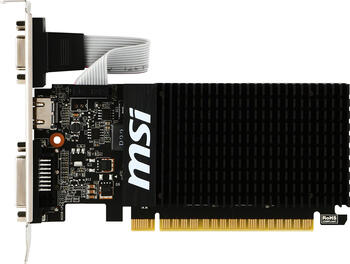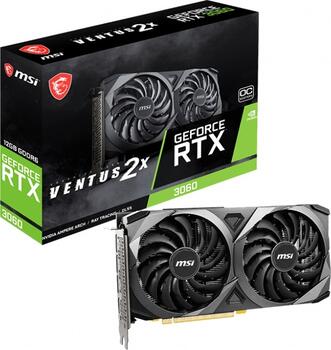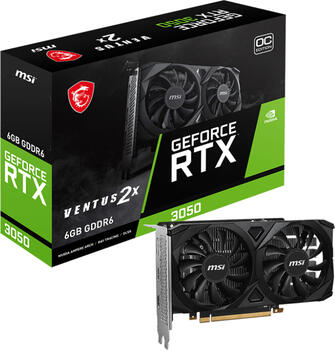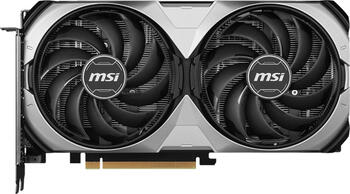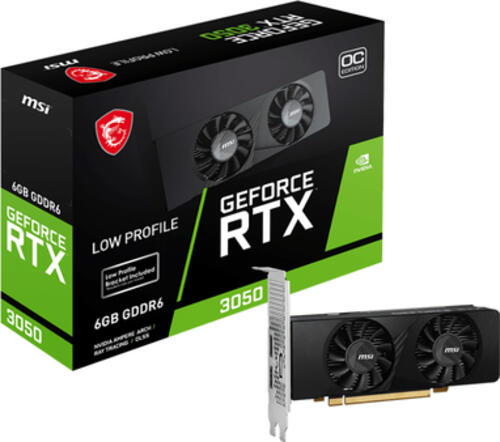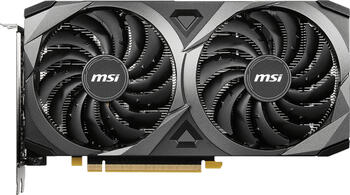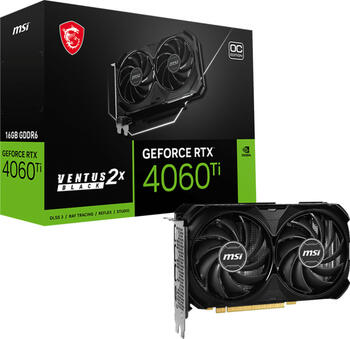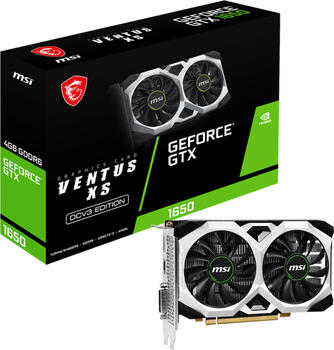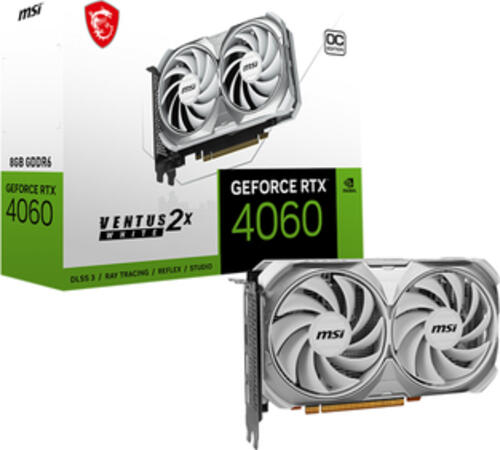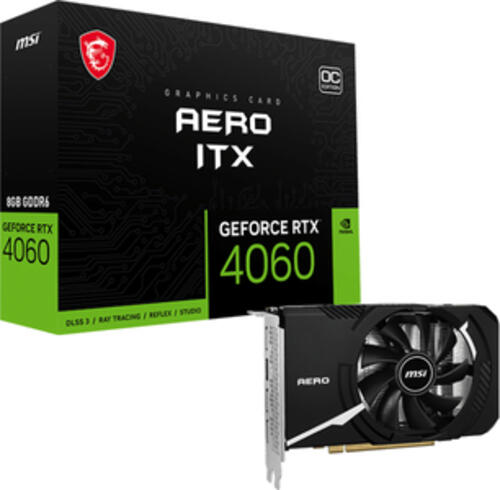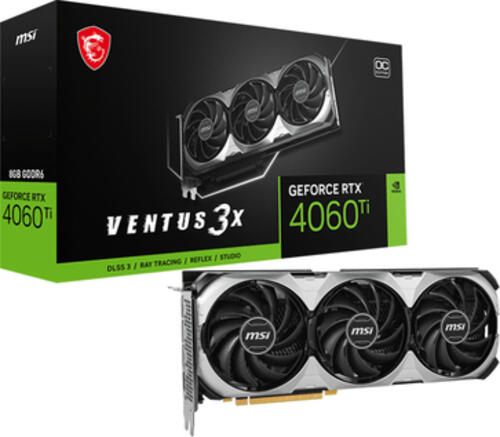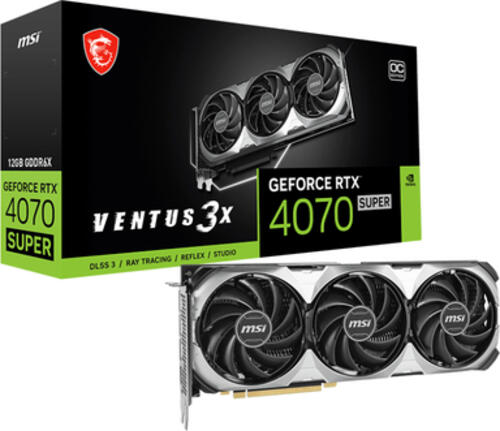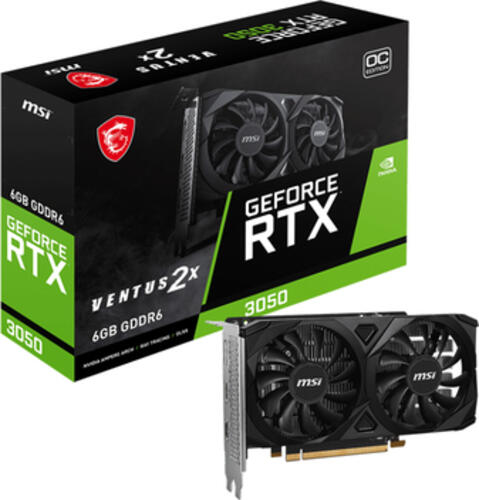- Modell: NVIDIA GeForce RTX 4060
- Speicher: 8GB GDDR6, 128bit, 17Gbps, 2125MHz, 272GB/s
- Takt Basis: 1830MHz (Standard-Profil), 1830MHz (OC-Profil)
- Takt Boost: 2505MHz (Standard-Profil), 2490MHz (OC-Profil)
- Übertaktung: +30MHz Boost (OC-Profil), +45MHz Boost (Standard-Profil)
- Kühlung: 2x Axial-Lüfter (90mm) mit 0dB-Zero-Fan-Modus
- TDP/TGP: 115W (NVIDIA), max. 115W (MSI)
- AI-Rechenleistung: +242 TOPS
- GPU-Rechenleistung: 15.39 TFLOPS (FP16), 15.39 TFLOPS (FP32), 0.24 TFLOPS (FP64)
- Stromanschlüsse: 1x 8-Pin PCIe
- Anschlüsse: 1x HDMI 2.1a, 3x DisplayPort 1.4a
- Anbindung: PCIe 4.0 x16 (x8)
- AI-Beschleunigung, Taktprofile (Default Mode/Extreme Performance), Backplate
- Gesamthöhe: Dual Slot
- Bauform: PCIe-Karte (full height)
- Slotblende: full height
- Chip-Daten:
- Chip-Architektur: Ada Lovelace (ab 2022/Q3)
- Chip-Bezeichnung: AD107-400-A1
- Chip-Konfiguration: 24SM (3072SP / 96TMU / 48ROP), 24 RT Cores, 96 Tensor Cores, 24MB L2-Cache
- Chip-Fertigung: TSMC 5nm NVIDIA 4N
- Chip-Größe: 159mm, monolithisch, 18.9 Mrd. Transistoren
- Chip-Funktionen: Raytracing (3rd Gen NVIDIA RTX), NVIDIA Tensor (4th Gen), HDCP 2.3
- API-Unterstützung: DirectX 12 Ultimate (12_2) / CUDA 8.9 / Vulkan 1.3 / OpenCL 3.0 / OpenGL 4.6 / Shader Model 6.7
- Transcoding-Engine: 1x NVENC (8th Gen, max. Sessions| 8), 1x NVDEC (5th Gen), Info
- Encoding: AV1, H.265 (4K YUV 4|2|0 / 4K YUV 4|4|4 / 4K Lossless / 8K / HEVC 10bit support / HEVC B Frame support), H.264 (YUV 4|2|0 / YUV 4|4|4 / Lossless)
- Decoding: AV1 (8bit / 10bit), H.265 (8bit 4|2|0 / 10bit 4|2|0 / 12bit 4|2|0 / 8bit 4|4|4 / 10bit 4|4|4 / 12bit 4|4|4), H.264, VP9 (8bit / 10bit / 12bit), VP8, VC-1, MPEG-2, MPEG-1
- Multi-GPU-Anbindung: -
- Vorstellung (Serie): 18.05.2023, Marktstart| 29.06.2023, UVP| 299 USD (NVIDIA)
- Grafik: NVIDIA GeForce RTX 4060 - 8GB GDDR6 - Desktop
weitere Informationen
bei Bestellung Versand am Montag, den 25.11
- Modell: NVIDIA GeForce RTX 3050 (GA107)
- Speicher: 8GB GDDR6, 128bit, 14Gbps, 1750MHz, 224GB/s
- Takt Basis: 1552MHz
- Takt Boost: 1807MHz
- Übertaktung: +30MHz Boost
- Kühlung: 2x Axial-Lüfter (100mm) mit 0dB-Zero-Fan-Modus
- TDP/TGP: 115W (NVIDIA)
- AI-Rechenleistung: +73 TOPS
- GPU-Rechenleistung: 9.25 TFLOPS (FP16), 9.25 TFLOPS (FP32), 0.14 TFLOPS (FP64)
- Stromanschlüsse: 1x 6-Pin PCIe
- Anschlüsse: 1x DVI, 1x HDMI 2.1, 1x DisplayPort 1.4a
- Anbindung: PCIe 4.0 x16 (x8)
- AI-Beschleunigung, Backplate, mit LHR (Lite Hash Rate)
- Gesamthöhe: Dual Slot
- Bauform: PCIe-Karte (full height)
- Slotblende: full height
- Chip-Daten:
- Chip-Architektur: Ampere (ab 2020/Q3)
- Chip-Bezeichnung: GA107-150-A1
- Chip-Konfiguration: 20SM (2560SP / 80TMU / 32ROP), 20 RT Cores, 80 Tensor Cores, 2MB L2-Cache
- Chip-Fertigung: Samsung 8nm
- Chip-Größe: 200mm, monolithisch, 8.7 Mrd. Transistoren
- Chip-Funktionen: Raytracing (2nd Gen NVIDIA RTX), NVIDIA Tensor (3rd Gen), HDCP 2.3
- API-Unterstützung: DirectX 12 Ultimate (12_2) / CUDA 8.6 / Vulkan 1.3 / OpenCL 3.0 / OpenGL 4.6 / Shader Model 6.7
- Transcoding-Engine: 1x NVENC (7th Gen, max. Sessions| 8), 1x NVDEC (5th Gen), Info
- Encoding: H.265 (4K YUV 4|2|0 / 4K YUV 4|4|4 / 4K Lossless / 8K / HEVC 10bit support / HEVC B Frame support), H.264 (YUV 4|2|0 / YUV 4|4|4 / Lossless)
- Decoding: AV1 (8bit / 10bit), H.265 (8bit 4|2|0 / 10bit 4|2|0 / 12bit 4|2|0 / 8bit 4|4|4 / 10bit 4|4|4 / 12bit 4|4|4), H.264, VP9 (8bit / 10bit / 12bit), VP8, VC-1, MPEG-2, MPEG-1
- Multi-GPU-Anbindung: -
- Vorstellung (Serie): 16.12.2022, UVP| 249 USD (NVIDIA)
- Grafik: NVIDIA GeForce RTX 3050 - 8GB GDDR6 - Desktop (GA107)
weitere Informationen
bei Bestellung Versand am Montag, den 25.11
- Modell: NVIDIA GeForce GT 710
- Speicher: 2GB DDR3, 64bit, 1.6Gbps, 800MHz, 13GB/s
- Takt Basis: 954MHz
- Takt Boost: unbekannt
- Übertaktung: -
- Kühlung: Passivkühlung
- TDP/TGP: 19W (NVIDIA)
- Stromanschlüsse: -
- Anschlüsse: 1x VGA, 1x DVI, 1x HDMI 1.4a
- Anbindung: PCIe 2.0 x16 (x8)
- Mini-ITX-Format (&8804;185mm)
- Gesamthöhe: Single Slot
- Bauform: PCIe-Karte (low profile)
- Slotblende: full height
- Chip-Daten:
- Chip-Architektur: Kepler 2.0 (ab 2013/Q2)
- Chip-Bezeichnung: GK208
- Chip-Konfiguration: 1SMX (192SP / 16TMU / 8ROP), 128kB L2-Cache
- Chip-Fertigung: TSMC 28nm
- Chip-Größe: 87mm, monolithisch, 915 Mio. Transistoren
- API-Unterstützung: DirectX 12 (11_0) / CUDA 3.5 / Vulkan 1.3 / OpenCL 3.0 / OpenGL 4.6 / Shader Model 5.1
- Transcoding-Engine: Info
- Encoding: -
- Decoding: -
- Multi-GPU-Anbindung: -
- Vorstellung (Serie): 27.03.2014
- Grafik: NVIDIA GeForce GT 710 - 2GB DDR3 - Desktop
weitere Informationen
bei Bestellung Versand am Montag, den 25.11
- Modell: NVIDIA GeForce RTX 3060
- Speicher: 12GB GDDR6, 192bit, 15Gbps, 1875MHz, 360GB/s
- Takt Basis: 1320MHz
- Takt Boost: 1807MHz
- Übertaktung: +30MHz Boost
- Kühlung: 2x Axial-Lüfter (100mm) mit 0dB-Zero-Fan-Modus
- TDP/TGP: 170W (NVIDIA), max. 170W (MSI)
- AI-Rechenleistung: +102 TOPS
- GPU-Rechenleistung: 12.95 TFLOPS (FP16), 12.95 TFLOPS (FP32), 0.2 TFLOPS (FP64)
- Stromanschlüsse: 1x 8-Pin PCIe
- Anschlüsse: 1x HDMI 2.1, 3x DisplayPort 1.4a
- Anbindung: PCIe 4.0 x16
- AI-Beschleunigung, Backplate, ohne LHR (Lite Hash Rate)
- Gesamthöhe: Dual Slot
- Bauform: PCIe-Karte (full height)
- Slotblende: full height
- Chip-Daten:
- Chip-Architektur: Ampere (ab 2020/Q3)
- Chip-Bezeichnung: GA106-300-A1
- Chip-Konfiguration: 28SM (3584SP / 112TMU / 48ROP), 28 RT Cores, 112 Tensor Cores, 3MB L2-Cache
- Chip-Fertigung: Samsung 8nm
- Chip-Größe: 276mm, monolithisch, 12 Mrd. Transistoren
- Chip-Funktionen: Raytracing (2nd Gen NVIDIA RTX), NVIDIA Tensor (3rd Gen), HDCP 2.3
- API-Unterstützung: DirectX 12 Ultimate (12_2) / CUDA 8.6 / Vulkan 1.3 / OpenCL 3.0 / OpenGL 4.6 / Shader Model 6.7
- Transcoding-Engine: 1x NVENC (7th Gen, max. Sessions| 8), 1x NVDEC (5th Gen), Info
- Encoding: H.265 (4K YUV 4|2|0 / 4K YUV 4|4|4 / 4K Lossless / 8K / HEVC 10bit support / HEVC B Frame support), H.264 (YUV 4|2|0 / YUV 4|4|4 / Lossless)
- Decoding: AV1 (8bit / 10bit), H.265 (8bit 4|2|0 / 10bit 4|2|0 / 12bit 4|2|0 / 8bit 4|4|4 / 10bit 4|4|4 / 12bit 4|4|4), H.264, VP9 (8bit / 10bit / 12bit), VP8, VC-1, MPEG-2, MPEG-1
- Multi-GPU-Anbindung: -
- Vorstellung (Serie): 12.01.2021, UVP| 329 USD (NVIDIA)
- Grafik: NVIDIA GeForce RTX 3060 - 12GB GDDR6 - Desktop
weitere Informationen
bei Bestellung Versand am Montag, den 25.11
- GPU: NVIDIA GeForce RTX 4060 Ti
- Speicher: 8GB GDDR6, 128bit, 18Gbps, 2250MHz, 288GB/s
- Takt Basis: 2310MHz (Standard-Profil), 2310MHz (OC-Profil)
- Takt Boost: 2640MHz (Standard-Profil), 2655MHz (OC-Profil)
- Übertaktung: +120MHz Boost (OC-Profil), +105MHz Boost (Standard-Profil)
- Kühlung: 2x Axial-Lüfter (100mm) mit 0dB-Zero-Fan-Modus
- TDP/TGP: 160W (NVIDIA), max. 160W (MSI)
- AI-Rechenleistung: 353 TOPS
- GPU-Rechenleistung: 23.11 TFLOPS (FP16), 23.11 TFLOPS (FP32), 0.36 TFLOPS (FP64)
- Stromanschlüsse: 1x 8-Pin PCIe
- Anschlüsse: 1x HDMI 2.1a, 3x DisplayPort 1.4a
- Anbindung: PCIe 4.0 x16 (x8)
- AI-Beschleunigung, Taktprofile (Default Mode/Extreme Performance), LED-Beleuchtung (RGB), Backplate
- Gesamthöhe: Dual Slot
- Bauform: PCIe-Karte (full height)
- Slotblende: full height
- Chip-Daten:
- Chip-Architektur: Ada Lovelace (ab 2022/Q3)
- Chip-Bezeichnung: AD106-350-A1
- Chip-Konfiguration: 34SM (4352SP / 136TMU / 48ROP), 34 RT Cores, 136 Tensor Cores, 32MB L2-Cache
- Chip-Fertigung: TSMC 5nm NVIDIA 4N
- Chip-Größe: 188mm, monolithisch, 22.9 Mrd. Transistoren
- Chip-Funktionen: Raytracing (3rd Gen NVIDIA RTX), NVIDIA Tensor (4th Gen), HDCP 2.3
- API-Unterstützung: DirectX 12 Ultimate (12_2) / CUDA 8.9 / Vulkan 1.3 / OpenCL 3.0 / OpenGL 4.6 / Shader Model 6.7
- Transcoding-Engine: 1x NVENC (8th Gen, max. Sessions| 8), 1x NVDEC (5th Gen), Info
- Encoding: AV1, H.265 (4K YUV 4|2|0 / 4K YUV 4|4|4 / 4K Lossless / 8K / HEVC 10bit support / HEVC B Frame support), H.264 (YUV 4|2|0 / YUV 4|4|4 / Lossless)
- Decoding: AV1 (8bit / 10bit), H.265 (8bit 4|2|0 / 10bit 4|2|0 / 12bit 4|2|0 / 8bit 4|4|4 / 10bit 4|4|4 / 12bit 4|4|4), H.264, VP9 (8bit / 10bit / 12bit), VP8, VC-1, MPEG-2, MPEG-1
- Multi-GPU-Anbindung: -
- Vorstellung (Serie): 18.05.2023, Marktstart| 24.05.2023, UVP| 399 USD (NVIDIA)
- Grafik: NVIDIA GeForce RTX 4060 Ti - 8GB GDDR6 - Desktop
weitere Informationen
- GPU: NVIDIA GeForce RTX 4060 Ti
- Speicher: 8GB GDDR6, 128bit, 18Gbps, 2250MHz, 288GB/s
- Takt Basis: 2310MHz (Standard-Profil), 2310MHz (OC-Profil)
- Takt Boost: 2565MHz (Standard-Profil), 2580MHz (OC-Profil)
- Übertaktung: +45MHz Boost (OC-Profil), +30MHz Boost (Standard-Profil)
- Kühlung: 2x Axial-Lüfter (90mm) mit 0dB-Zero-Fan-Modus
- TDP/TGP: 160W (NVIDIA), max. 160W (MSI)
- AI-Rechenleistung: 353 TOPS
- GPU-Rechenleistung: 22.46 TFLOPS (FP16), 22.46 TFLOPS (FP32), 0.35 TFLOPS (FP64)
- Stromanschlüsse: 1x 8-Pin PCIe
- Anschlüsse: 1x HDMI 2.1a, 3x DisplayPort 1.4a
- Anbindung: PCIe 4.0 x16 (x8)
- AI-Beschleunigung, Taktprofile (Default Mode/Extreme Performance), Backplate
- Gesamthöhe: Dual Slot
- Bauform: PCIe-Karte (full height)
- Slotblende: full height
- Chip-Daten:
- Chip-Architektur: Ada Lovelace (ab 2022/Q3)
- Chip-Bezeichnung: AD106-350-A1
- Chip-Konfiguration: 34SM (4352SP / 136TMU / 48ROP), 34 RT Cores, 136 Tensor Cores, 32MB L2-Cache
- Chip-Fertigung: TSMC 5nm NVIDIA 4N
- Chip-Größe: 188mm, monolithisch, 22.9 Mrd. Transistoren
- Chip-Funktionen: Raytracing (3rd Gen NVIDIA RTX), NVIDIA Tensor (4th Gen), HDCP 2.3
- API-Unterstützung: DirectX 12 Ultimate (12_2) / CUDA 8.9 / Vulkan 1.3 / OpenCL 3.0 / OpenGL 4.6 / Shader Model 6.7
- Transcoding-Engine: 1x NVENC (8th Gen, max. Sessions| 8), 1x NVDEC (5th Gen), Info
- Encoding: AV1, H.265 (4K YUV 4|2|0 / 4K YUV 4|4|4 / 4K Lossless / 8K / HEVC 10bit support / HEVC B Frame support), H.264 (YUV 4|2|0 / YUV 4|4|4 / Lossless)
- Decoding: AV1 (8bit / 10bit), H.265 (8bit 4|2|0 / 10bit 4|2|0 / 12bit 4|2|0 / 8bit 4|4|4 / 10bit 4|4|4 / 12bit 4|4|4), H.264, VP9 (8bit / 10bit / 12bit), VP8, VC-1, MPEG-2, MPEG-1
- Multi-GPU-Anbindung: -
- Vorstellung (Serie): 18.05.2023, Marktstart| 24.05.2023, UVP| 399 USD (NVIDIA)
- Grafik: NVIDIA GeForce RTX 4060 Ti - 8GB GDDR6 - Desktop
weitere Informationen
- GPU: NVIDIA GeForce RTX 4060 Ti
- Speicher: 16GB GDDR6, 128bit, 18Gbps, 2250MHz, 288GB/s
- Takt Basis: 2310MHz (Standard-Profil), 2310MHz (OC-Profil)
- Takt Boost: 2670MHz (Standard-Profil), 2685MHz (OC-Profil)
- Übertaktung: +150MHz Boost (OC-Profil), +135MHz Boost (Standard-Profil)
- Kühlung: 3x Axial-Lüfter (90mm) mit 0dB-Zero-Fan-Modus
- TDP/TGP: 165W (NVIDIA), max. 165W (MSI)
- AI-Rechenleistung: 353 TOPS
- GPU-Rechenleistung: 23.37 TFLOPS (FP16), 23.37 TFLOPS (FP32), 0.37 TFLOPS (FP64)
- Stromanschlüsse: 1x 8-Pin PCIe
- Anschlüsse: 1x HDMI 2.1a, 3x DisplayPort 1.4a
- Anbindung: PCIe 4.0 x16 (x8)
- AI-Beschleunigung, Taktprofile (Default Mode/Extreme Performance), LED-Beleuchtung (RGB), Backplate, Grafikkarten-Halterung
- Gesamthöhe: Dual Slot
- Bauform: PCIe-Karte (full height)
- Slotblende: full height
- Chip-Daten:
- Chip-Architektur: Ada Lovelace (ab 2022/Q3)
- Chip-Bezeichnung: AD106-351-A1
- Chip-Konfiguration: 34SM (4352SP / 136TMU / 48ROP), 34 RT Cores, 136 Tensor Cores, 32MB L2-Cache
- Chip-Fertigung: TSMC 5nm NVIDIA 4N
- Chip-Größe: 188mm, monolithisch, 22.9 Mrd. Transistoren
- Chip-Funktionen: Raytracing (3rd Gen NVIDIA RTX), NVIDIA Tensor (4th Gen), HDCP 2.3
- API-Unterstützung: DirectX 12 Ultimate (12_2) / CUDA 8.9 / Vulkan 1.3 / OpenCL 3.0 / OpenGL 4.6 / Shader Model 6.7
- Transcoding-Engine: 1x NVENC (8th Gen, max. Sessions| 8), 1x NVDEC (5th Gen), Info
- Encoding: AV1, H.265 (4K YUV 4|2|0 / 4K YUV 4|4|4 / 4K Lossless / 8K / HEVC 10bit support / HEVC B Frame support), H.264 (YUV 4|2|0 / YUV 4|4|4 / Lossless)
- Decoding: AV1 (8bit / 10bit), H.265 (8bit 4|2|0 / 10bit 4|2|0 / 12bit 4|2|0 / 8bit 4|4|4 / 10bit 4|4|4 / 12bit 4|4|4), H.264, VP9 (8bit / 10bit / 12bit), VP8, VC-1, MPEG-2, MPEG-1
- Multi-GPU-Anbindung: -
- Vorstellung (Serie): 18.05.2023, Marktstart| 18.07.2023, UVP| 499 USD (NVIDIA)
- Grafik: NVIDIA GeForce RTX 4060 Ti - 16GB GDDR6 - Desktop
weitere Informationen
- Modell: NVIDIA GeForce RTX 4080 SUPER
- Speicher: 16GB GDDR6X, 256bit, 23Gbps, 1438MHz, 736GB/s
- Takt Basis: 2295MHz (Standard-Profil), 2295MHz (OC-Profil)
- Takt Boost: 2610MHz (Standard-Profil), 2625MHz (OC-Profil)
- Übertaktung: +75MHz Boost (OC-Profil), +60MHz Boost (Standard-Profil)
- Kühlung: 3x Axial-Lüfter (100mm) mit 0dB-Zero-Fan-Modus
- TDP/TGP: 320W (NVIDIA), max. 320W (MSI)
- AI-Rechenleistung: +836 TOPS
- GPU-Rechenleistung: 53.76 TFLOPS (FP16), 53.76 TFLOPS (FP32), 0.84 TFLOPS (FP64)
- Stromanschlüsse: 1x 16-Pin PCIe 5.0 (via Adapter| 3x 8-Pin PCIe)
- Anschlüsse: 2x HDMI 2.1a, 2x DisplayPort 1.4a
- Anbindung: PCIe 4.0 x16
- AI-Beschleunigung, Taktprofile (Default Mode/Extreme Performance), LED-Beleuchtung (RGB), Backplate, Grafikkarten-Halterung
- Gesamthöhe: Triple Slot
- Bauform: PCIe-Karte (full height)
- Slotblende: full height
- Chip-Daten:
- Chip-Architektur: Ada Lovelace (ab 2022/Q3)
- Chip-Bezeichnung: AD103-400-A1
- Chip-Konfiguration: 80SM (10240SP / 320TMU / 112ROP), 80 RT Cores, 320 Tensor Cores, 64MB L2-Cache
- Chip-Fertigung: TSMC 5nm NVIDIA 4N
- Chip-Größe: 379mm, monolithisch, 45.9 Mrd. Transistoren
- Chip-Funktionen: Raytracing (3rd Gen NVIDIA RTX), NVIDIA Tensor (4th Gen), HDCP 2.3
- API-Unterstützung: DirectX 12 Ultimate (12_2) / CUDA 8.9 / Vulkan 1.3 / OpenCL 3.0 / OpenGL 4.6 / Shader Model 6.7
- Transcoding-Engine: 2x NVENC (8th Gen, max. Sessions| 8), 1x NVDEC (5th Gen), Info
- Encoding: AV1, H.265 (4K YUV 4|2|0 / 4K YUV 4|4|4 / 4K Lossless / 8K / HEVC 10bit support / HEVC B Frame support), H.264 (YUV 4|2|0 / YUV 4|4|4 / Lossless)
- Decoding: AV1 (8bit / 10bit), H.265 (8bit 4|2|0 / 10bit 4|2|0 / 12bit 4|2|0 / 8bit 4|4|4 / 10bit 4|4|4 / 12bit 4|4|4), H.264, VP9 (8bit / 10bit / 12bit), VP8, VC-1, MPEG-2, MPEG-1
- Multi-GPU-Anbindung: -
- Vorstellung (Serie): 08.01.2024, Marktstart| 31.01.2024, UVP| 999 USD (NVIDIA)
- Grafik: NVIDIA GeForce RTX 4080 SUPER - 16GB GDDR6X - Desktop
weitere Informationen
- GPU: NVIDIA GeForce RTX 3050
- Speicher: 6GB GDDR6, 96bit, 14Gbps, 1750MHz, 168GB/s
- Takt Basis: 1042MHz
- Takt Boost: 1492MHz
- Übertaktung: +22MHz Boost
- Kühlung: 2x Axial-Lüfter (80mm)
- TDP/TGP: 70W (NVIDIA)
- AI-Rechenleistung: 73 TOPS
- GPU-Rechenleistung: 6.88 TFLOPS (FP16), 6.88 TFLOPS (FP32), 0.11 TFLOPS (FP64)
- Stromanschlüsse: -
- Anschlüsse: 2x HDMI 2.1, 1x DisplayPort 1.4a
- Anbindung: PCIe 4.0 x16 (x8)
- AI-Beschleunigung, ohne LHR (Lite Hash Rate)
- Gesamthöhe: Dual Slot
- Bauform: PCIe-Karte (full height)
- Slotblende: full height
- Chip-Daten:
- Chip-Architektur: Ampere (ab 2020/Q3)
- Chip-Bezeichnung: GA107-325-K2-A1
- Chip-Konfiguration: 18SM (2304SP / 72TMU / 32ROP), 18 RT Cores, 72 Tensor Cores, 2MB L2-Cache
- Chip-Fertigung: Samsung 8nm
- Chip-Größe: 200mm, monolithisch, 8.7 Mrd. Transistoren
- Chip-Funktionen: Raytracing (2nd Gen NVIDIA RTX), NVIDIA Tensor (3rd Gen), HDCP 2.3
- API-Unterstützung: DirectX 12 Ultimate (12_2) / CUDA 8.6 / Vulkan 1.3 / OpenCL 3.0 / OpenGL 4.6 / Shader Model 6.7
- Transcoding-Engine: 1x NVENC (7th Gen, max. Sessions| 8), 1x NVDEC (5th Gen), Info
- Encoding: H.265 (4K YUV 4|2|0 / 4K YUV 4|4|4 / 4K Lossless / 8K / HEVC 10bit support / HEVC B Frame support), H.264 (YUV 4|2|0 / YUV 4|4|4 / Lossless)
- Decoding: AV1 (8bit / 10bit), H.265 (8bit 4|2|0 / 10bit 4|2|0 / 12bit 4|2|0 / 8bit 4|4|4 / 10bit 4|4|4 / 12bit 4|4|4), H.264, VP9 (8bit / 10bit / 12bit), VP8, VC-1, MPEG-2, MPEG-1
- Multi-GPU-Anbindung: -
- Vorstellung (Serie): 02.02.2024, UVP| 179 USD (NVIDIA)
- Grafik: NVIDIA GeForce RTX 3050 - 6GB GDDR6 - Desktop
weitere Informationen
- Modell: NVIDIA GeForce RTX 4070
- Speicher: 12GB GDDR6, 192bit, 20Gbps, 2500MHz, 480GB/s
- Takt Basis: 1920MHz (Standard-Profil), 1920MHz (OC-Profil)
- Takt Boost: 2505MHz (Standard-Profil), 2520MHz (OC-Profil)
- Übertaktung: +45MHz Boost (OC-Profil), +30MHz Boost (Standard-Profil)
- Kühlung: 2x Axial-Lüfter (100mm) mit 0dB-Zero-Fan-Modus
- TDP/TGP: 200W (NVIDIA), max. 200W (MSI)
- AI-Rechenleistung: +466 TOPS
- GPU-Rechenleistung: 29.68 TFLOPS (FP16), 29.68 TFLOPS (FP32), 0.46 TFLOPS (FP64)
- Stromanschlüsse: 1x 8-Pin PCIe
- Anschlüsse: 1x HDMI 2.1a, 3x DisplayPort 1.4a
- Anbindung: PCIe 4.0 x16
- AI-Beschleunigung, Taktprofile (Default Mode/Extreme Performance), Backplate, NVIDIA GeForce SFF-Ready
- Gesamthöhe: Dual Slot
- Bauform: PCIe-Karte (full height)
- Slotblende: full height
- Chip-Daten:
- Chip-Architektur: Ada Lovelace (ab 2022/Q3)
- Chip-Bezeichnung: AD104-2XX-A1
- Chip-Konfiguration: 46SM (5888SP / 184TMU / 64ROP), 46 RT Cores, 184 Tensor Cores, 36MB L2-Cache
- Chip-Fertigung: TSMC 5nm NVIDIA 4N
- Chip-Größe: 294mm, monolithisch, 35.8 Mrd. Transistoren
- Chip-Funktionen: Raytracing (3rd Gen NVIDIA RTX), NVIDIA Tensor (4th Gen), HDCP 2.3
- API-Unterstützung: DirectX 12 Ultimate (12_2) / CUDA 8.9 / Vulkan 1.3 / OpenCL 3.0 / OpenGL 4.6 / Shader Model 6.7
- Transcoding-Engine: 1x NVENC (8th Gen, max. Sessions| 8), 1x NVDEC (5th Gen), Info
- Encoding: AV1, H.265 (4K YUV 4|2|0 / 4K YUV 4|4|4 / 4K Lossless / 8K / HEVC 10bit support / HEVC B Frame support), H.264 (YUV 4|2|0 / YUV 4|4|4 / Lossless)
- Decoding: AV1 (8bit / 10bit), H.265 (8bit 4|2|0 / 10bit 4|2|0 / 12bit 4|2|0 / 8bit 4|4|4 / 10bit 4|4|4 / 12bit 4|4|4), H.264, VP9 (8bit / 10bit / 12bit), VP8, VC-1, MPEG-2, MPEG-1
- Multi-GPU-Anbindung: -
- Vorstellung (Serie): 20.08.2024, UVP| 599 USD (NVIDIA)
- Grafik: NVIDIA GeForce RTX 4070 - 12GB GDDR6 - Desktop
weitere Informationen
- GPU: NVIDIA GeForce RTX 3050
- Speicher: 6GB GDDR6, 96bit, 14Gbps, 1750MHz, 168GB/s
- Takt Basis: 1042MHz
- Takt Boost: 1492MHz
- Übertaktung: +22MHz Boost
- Kühlung: 2x Axial-Lüfter (50mm)
- TDP/TGP: 70W (NVIDIA)
- AI-Rechenleistung: 73 TOPS
- GPU-Rechenleistung: 6.88 TFLOPS (FP16), 6.88 TFLOPS (FP32), 0.11 TFLOPS (FP64)
- Stromanschlüsse: -
- Anschlüsse: 2x HDMI 2.1, 1x DisplayPort 1.4a
- Anbindung: PCIe 4.0 x16 (x8)
- AI-Beschleunigung, ohne LHR (Lite Hash Rate), Mini-ITX-Format (&8804;185mm)
- Gesamthöhe: Dual Slot
- Bauform: PCIe-Karte (low profile)
- Slotblende: full height + low profile (Lieferumfang)
- Chip-Daten:
- Chip-Architektur: Ampere (ab 2020/Q3)
- Chip-Bezeichnung: GA107-325-K2-A1
- Chip-Konfiguration: 18SM (2304SP / 72TMU / 32ROP), 18 RT Cores, 72 Tensor Cores, 2MB L2-Cache
- Chip-Fertigung: Samsung 8nm
- Chip-Größe: 200mm, monolithisch, 8.7 Mrd. Transistoren
- Chip-Funktionen: Raytracing (2nd Gen NVIDIA RTX), NVIDIA Tensor (3rd Gen), HDCP 2.3
- API-Unterstützung: DirectX 12 Ultimate (12_2) / CUDA 8.6 / Vulkan 1.3 / OpenCL 3.0 / OpenGL 4.6 / Shader Model 6.7
- Transcoding-Engine: 1x NVENC (7th Gen, max. Sessions| 8), 1x NVDEC (5th Gen), Info
- Encoding: H.265 (4K YUV 4|2|0 / 4K YUV 4|4|4 / 4K Lossless / 8K / HEVC 10bit support / HEVC B Frame support), H.264 (YUV 4|2|0 / YUV 4|4|4 / Lossless)
- Decoding: AV1 (8bit / 10bit), H.265 (8bit 4|2|0 / 10bit 4|2|0 / 12bit 4|2|0 / 8bit 4|4|4 / 10bit 4|4|4 / 12bit 4|4|4), H.264, VP9 (8bit / 10bit / 12bit), VP8, VC-1, MPEG-2, MPEG-1
- Multi-GPU-Anbindung: -
- Vorstellung (Serie): 02.02.2024, UVP| 179 USD (NVIDIA)
- Grafik: NVIDIA GeForce RTX 3050 - 6GB GDDR6 - Desktop
weitere Informationen
- Modell: NVIDIA GeForce RTX 3060
- Speicher: 8GB GDDR6, 128bit, 15Gbps, 1875MHz, 240GB/s
- Takt Basis: 1320MHz
- Takt Boost: 1807MHz
- Übertaktung: +30MHz Boost
- Kühlung: 2x Axial-Lüfter (100mm) mit 0dB-Zero-Fan-Modus
- TDP/TGP: 170W (NVIDIA), max. 170W (MSI)
- AI-Rechenleistung: +102 TOPS
- GPU-Rechenleistung: 12.95 TFLOPS (FP16), 12.95 TFLOPS (FP32), 0.2 TFLOPS (FP64)
- Stromanschlüsse: 1x 8-Pin PCIe
- Anschlüsse: 1x HDMI 2.1, 3x DisplayPort 1.4a
- Anbindung: PCIe 4.0 x16
- AI-Beschleunigung, Backplate, ohne LHR (Lite Hash Rate)
- Gesamthöhe: Dual Slot
- Bauform: PCIe-Karte (full height)
- Slotblende: full height
- Chip-Daten:
- Chip-Architektur: Ampere (ab 2020/Q3)
- Chip-Bezeichnung: GA106-302-A1
- Chip-Konfiguration: 28SM (3584SP / 112TMU / 48ROP), 28 RT Cores, 112 Tensor Cores, 3MB L2-Cache
- Chip-Fertigung: Samsung 8nm
- Chip-Größe: 276mm, monolithisch, 12 Mrd. Transistoren
- Chip-Funktionen: Raytracing (2nd Gen NVIDIA RTX), NVIDIA Tensor (3rd Gen), HDCP 2.3
- API-Unterstützung: DirectX 12 Ultimate (12_2) / CUDA 8.6 / Vulkan 1.3 / OpenCL 3.0 / OpenGL 4.6 / Shader Model 6.7
- Transcoding-Engine: 1x NVENC (7th Gen, max. Sessions| 8), 1x NVDEC (5th Gen), Info
- Encoding: H.265 (4K YUV 4|2|0 / 4K YUV 4|4|4 / 4K Lossless / 8K / HEVC 10bit support / HEVC B Frame support), H.264 (YUV 4|2|0 / YUV 4|4|4 / Lossless)
- Decoding: AV1 (8bit / 10bit), H.265 (8bit 4|2|0 / 10bit 4|2|0 / 12bit 4|2|0 / 8bit 4|4|4 / 10bit 4|4|4 / 12bit 4|4|4), H.264, VP9 (8bit / 10bit / 12bit), VP8, VC-1, MPEG-2, MPEG-1
- Multi-GPU-Anbindung: -
- Vorstellung (Serie): 12.10.2022, UVP| 329 USD (NVIDIA)
- Grafik: NVIDIA GeForce RTX 3060 - 8GB GDDR6 - Desktop
weitere Informationen
- GPU: NVIDIA GeForce RTX 4060 Ti
- Speicher: 16GB GDDR6, 128bit, 18Gbps, 2250MHz, 288GB/s
- Takt Basis: 2310MHz (Standard-Profil), 2310MHz (OC-Profil)
- Takt Boost: 2610MHz (Standard-Profil), 2625MHz (OC-Profil)
- Übertaktung: +90MHz Boost (OC-Profil), +75MHz Boost (Standard-Profil)
- Kühlung: 2x Axial-Lüfter (90mm) mit 0dB-Zero-Fan-Modus
- TDP/TGP: 165W (NVIDIA), max. 165W (MSI)
- AI-Rechenleistung: 353 TOPS
- GPU-Rechenleistung: 22.85 TFLOPS (FP16), 22.85 TFLOPS (FP32), 0.36 TFLOPS (FP64)
- Stromanschlüsse: 1x 8-Pin PCIe
- Anschlüsse: 1x HDMI 2.1a, 3x DisplayPort 1.4a
- Anbindung: PCIe 4.0 x16 (x8)
- AI-Beschleunigung, Taktprofile (Default Mode/Extreme Performance), Backplate
- Gesamthöhe: Dual Slot
- Bauform: PCIe-Karte (full height)
- Slotblende: full height
- Chip-Daten:
- Chip-Architektur: Ada Lovelace (ab 2022/Q3)
- Chip-Bezeichnung: AD106-351-A1
- Chip-Konfiguration: 34SM (4352SP / 136TMU / 48ROP), 34 RT Cores, 136 Tensor Cores, 32MB L2-Cache
- Chip-Fertigung: TSMC 5nm NVIDIA 4N
- Chip-Größe: 188mm, monolithisch, 22.9 Mrd. Transistoren
- Chip-Funktionen: Raytracing (3rd Gen NVIDIA RTX), NVIDIA Tensor (4th Gen), HDCP 2.3
- API-Unterstützung: DirectX 12 Ultimate (12_2) / CUDA 8.9 / Vulkan 1.3 / OpenCL 3.0 / OpenGL 4.6 / Shader Model 6.7
- Transcoding-Engine: 1x NVENC (8th Gen, max. Sessions| 8), 1x NVDEC (5th Gen), Info
- Encoding: AV1, H.265 (4K YUV 4|2|0 / 4K YUV 4|4|4 / 4K Lossless / 8K / HEVC 10bit support / HEVC B Frame support), H.264 (YUV 4|2|0 / YUV 4|4|4 / Lossless)
- Decoding: AV1 (8bit / 10bit), H.265 (8bit 4|2|0 / 10bit 4|2|0 / 12bit 4|2|0 / 8bit 4|4|4 / 10bit 4|4|4 / 12bit 4|4|4), H.264, VP9 (8bit / 10bit / 12bit), VP8, VC-1, MPEG-2, MPEG-1
- Multi-GPU-Anbindung: -
- Vorstellung (Serie): 18.05.2023, Marktstart| 18.07.2023, UVP| 499 USD (NVIDIA)
- Grafik: NVIDIA GeForce RTX 4060 Ti - 16GB GDDR6 - Desktop
weitere Informationen
- Modell: NVIDIA GeForce RTX 4070 SUPER
- Speicher: 12GB GDDR6X, 192bit, 21Gbps, 1313MHz, 504GB/s
- Takt Basis: 1980MHz (Standard-Profil), 1980MHz (OC-Profil)
- Takt Boost: 2505MHz (Standard-Profil), 2520MHz (OC-Profil)
- Übertaktung: +45MHz Boost (OC-Profil), +30MHz Boost (Standard-Profil)
- Kühlung: 2x Axial-Lüfter (100mm) mit 0dB-Zero-Fan-Modus
- TDP/TGP: 220W (NVIDIA), max. 220W (MSI)
- AI-Rechenleistung: +568 TOPS
- GPU-Rechenleistung: 36.13 TFLOPS (FP16), 36.13 TFLOPS (FP32), 0.56 TFLOPS (FP64)
- Stromanschlüsse: 1x 16-Pin PCIe 5.0 (via Adapter| 2x 8-Pin PCIe)
- Anschlüsse: 1x HDMI 2.1a, 3x DisplayPort 1.4a
- Anbindung: PCIe 4.0 x16
- AI-Beschleunigung, Taktprofile (Default Mode/Extreme Performance), Backplate, NVIDIA GeForce SFF-Ready
- Gesamthöhe: Dual Slot
- Bauform: PCIe-Karte (full height)
- Slotblende: full height
- Chip-Daten:
- Chip-Architektur: Ada Lovelace (ab 2022/Q3)
- Chip-Bezeichnung: AD104-350-A1
- Chip-Konfiguration: 56SM (7168SP / 224TMU / 80ROP), 56 RT Cores, 224 Tensor Cores, 48MB L2-Cache
- Chip-Fertigung: TSMC 5nm NVIDIA 4N
- Chip-Größe: 294mm, monolithisch, 35.8 Mrd. Transistoren
- Chip-Funktionen: Raytracing (3rd Gen NVIDIA RTX), NVIDIA Tensor (4th Gen), HDCP 2.3
- API-Unterstützung: DirectX 12 Ultimate (12_2) / CUDA 8.9 / Vulkan 1.3 / OpenCL 3.0 / OpenGL 4.6 / Shader Model 6.7
- Transcoding-Engine: 1x NVENC (8th Gen, max. Sessions| 8), 1x NVDEC (5th Gen), Info
- Encoding: AV1, H.265 (4K YUV 4|2|0 / 4K YUV 4|4|4 / 4K Lossless / 8K / HEVC 10bit support / HEVC B Frame support), H.264 (YUV 4|2|0 / YUV 4|4|4 / Lossless)
- Decoding: AV1 (8bit / 10bit), H.265 (8bit 4|2|0 / 10bit 4|2|0 / 12bit 4|2|0 / 8bit 4|4|4 / 10bit 4|4|4 / 12bit 4|4|4), H.264, VP9 (8bit / 10bit / 12bit), VP8, VC-1, MPEG-2, MPEG-1
- Multi-GPU-Anbindung: -
- Vorstellung (Serie): 08.01.2024, Marktstart| 17.01.2024, UVP| 599 USD (NVIDIA)
- Grafik: NVIDIA GeForce RTX 4070 SUPER - 12GB GDDR6X - Desktop
weitere Informationen
- Modell: NVIDIA GeForce GTX 1650
- Speicher: 4GB GDDR6, 128bit, 12Gbps, 1500MHz, 192GB/s
- Takt Basis: 1410MHz
- Takt Boost: 1620MHz
- Übertaktung: +30MHz Boost
- Kühlung: 2x Axial-Lüfter (75mm)
- TDP/TGP: 75W (NVIDIA), max. 90W (MSI)
- GPU-Rechenleistung: 5.81 TFLOPS (FP16), 2.9 TFLOPS (FP32), 0.09 TFLOPS (FP64)
- Stromanschlüsse: 1x 6-Pin PCIe
- Anschlüsse: 1x DVI, 1x HDMI 2.0b, 1x DisplayPort 1.4a
- Anbindung: PCIe 3.0 x16
- Mini-ITX-Format (&8804;185mm)
- Gesamthöhe: Dual Slot
- Bauform: PCIe-Karte (full height)
- Slotblende: full height
- Chip-Daten:
- Chip-Architektur: Turing (ab 2019/Q1)
- Chip-Bezeichnung: TU117-300-A1
- Chip-Konfiguration: 14SM (896SP / 56TMU / 32ROP), 1MB L2-Cache
- Chip-Fertigung: TSMC 12nm
- Chip-Größe: 200mm, monolithisch, 4.7 Mrd. Transistoren
- Chip-Funktionen: HDCP 2.2
- API-Unterstützung: DirectX 12 (12_1) / CUDA 7.5 / Vulkan 1.3 / OpenCL 3.0 / OpenGL 4.6 / Shader Model 6.7
- Transcoding-Engine: 1x NVENC (6th Gen, max. Sessions| 8), 1x NVDEC (4th Gen), Info
- Encoding: H.265 (4K YUV 4|2|0 / 4K YUV 4|4|4 / 4K Lossless / 8K / HEVC 10bit support), H.264 (YUV 4|2|0 / YUV 4|4|4 / Lossless)
- Decoding: H.265 (8bit 4|2|0 / 10bit 4|2|0 / 12bit 4|2|0 / 8bit 4|4|4 / 10bit 4|4|4 / 12bit 4|4|4), H.264, VP9 (8bit / 10bit / 12bit), VP8, VC-1, MPEG-2, MPEG-1
- Multi-GPU-Anbindung: -
- Vorstellung (Serie): 01.04.2020, UVP| 149 USD (NVIDIA)
- Grafik: NVIDIA GeForce GTX 1650 - 4GB GDDR6 - Desktop
weitere Informationen
- GPU: NVIDIA GeForce RTX 4060
- Speicher: 8GB GDDR6, 128bit, 17Gbps, 2125MHz, 272GB/s
- Takt Basis: 1830MHz (Standard-Profil), 1830MHz (OC-Profil)
- Takt Boost: 2505MHz (Standard-Profil), 2490MHz (OC-Profil)
- Übertaktung: +30MHz Boost (OC-Profil), +45MHz Boost (Standard-Profil)
- Kühlung: 2x Axial-Lüfter (90mm) mit 0dB-Zero-Fan-Modus
- TDP/TGP: 115W (NVIDIA), max. 115W (MSI)
- AI-Rechenleistung: 242 TOPS
- GPU-Rechenleistung: 15.39 TFLOPS (FP16), 15.39 TFLOPS (FP32), 0.24 TFLOPS (FP64)
- Stromanschlüsse: 1x 8-Pin PCIe
- Anschlüsse: 1x HDMI 2.1a, 3x DisplayPort 1.4a
- Anbindung: PCIe 4.0 x16 (x8)
- AI-Beschleunigung, Taktprofile (Default Mode/Extreme Performance), Backplate, White Build-kompatibel (weiße Farbgebung)
- Gesamthöhe: Dual Slot
- Bauform: PCIe-Karte (full height)
- Slotblende: full height
- Chip-Daten:
- Chip-Architektur: Ada Lovelace (ab 2022/Q3)
- Chip-Bezeichnung: AD107-400-A1
- Chip-Konfiguration: 24SM (3072SP / 96TMU / 48ROP), 24 RT Cores, 96 Tensor Cores, 24MB L2-Cache
- Chip-Fertigung: TSMC 5nm NVIDIA 4N
- Chip-Größe: 159mm, monolithisch, 18.9 Mrd. Transistoren
- Chip-Funktionen: Raytracing (3rd Gen NVIDIA RTX), NVIDIA Tensor (4th Gen), HDCP 2.3
- API-Unterstützung: DirectX 12 Ultimate (12_2) / CUDA 8.9 / Vulkan 1.3 / OpenCL 3.0 / OpenGL 4.6 / Shader Model 6.7
- Transcoding-Engine: 1x NVENC (8th Gen, max. Sessions| 8), 1x NVDEC (5th Gen), Info
- Encoding: AV1, H.265 (4K YUV 4|2|0 / 4K YUV 4|4|4 / 4K Lossless / 8K / HEVC 10bit support / HEVC B Frame support), H.264 (YUV 4|2|0 / YUV 4|4|4 / Lossless)
- Decoding: AV1 (8bit / 10bit), H.265 (8bit 4|2|0 / 10bit 4|2|0 / 12bit 4|2|0 / 8bit 4|4|4 / 10bit 4|4|4 / 12bit 4|4|4), H.264, VP9 (8bit / 10bit / 12bit), VP8, VC-1, MPEG-2, MPEG-1
- Multi-GPU-Anbindung: -
- Vorstellung (Serie): 18.05.2023, Marktstart| 29.06.2023, UVP| 299 USD (NVIDIA)
- Grafik: NVIDIA GeForce RTX 4060 - 8GB GDDR6 - Desktop
weitere Informationen
- GPU: NVIDIA GeForce RTX 4060
- Speicher: 8GB GDDR6, 128bit, 17Gbps, 2125MHz, 272GB/s
- Takt Basis: 1830MHz (Standard-Profil), 1830MHz (OC-Profil)
- Takt Boost: 2490MHz (Standard-Profil), 2505MHz (OC-Profil)
- Übertaktung: +45MHz Boost (OC-Profil), +30MHz Boost (Standard-Profil)
- Kühlung: 1x Axial-Lüfter (90mm) mit 0dB-Zero-Fan-Modus
- TDP/TGP: 115W (NVIDIA), max. 115W (MSI)
- AI-Rechenleistung: 242 TOPS
- GPU-Rechenleistung: 15.39 TFLOPS (FP16), 15.39 TFLOPS (FP32), 0.24 TFLOPS (FP64)
- Stromanschlüsse: 1x 8-Pin PCIe
- Anschlüsse: 1x HDMI 2.1a, 3x DisplayPort 1.4a
- Anbindung: PCIe 4.0 x16 (x8)
- AI-Beschleunigung, Taktprofile (Default Mode/Extreme Performance), Backplate, Mini-ITX-Format (&8804;185mm)
- Gesamthöhe: Dual Slot
- Bauform: PCIe-Karte (full height)
- Slotblende: full height
- Chip-Daten:
- Chip-Architektur: Ada Lovelace (ab 2022/Q3)
- Chip-Bezeichnung: AD107-400-A1
- Chip-Konfiguration: 24SM (3072SP / 96TMU / 48ROP), 24 RT Cores, 96 Tensor Cores, 24MB L2-Cache
- Chip-Fertigung: TSMC 5nm NVIDIA 4N
- Chip-Größe: 159mm, monolithisch, 18.9 Mrd. Transistoren
- Chip-Funktionen: Raytracing (3rd Gen NVIDIA RTX), NVIDIA Tensor (4th Gen), HDCP 2.3
- API-Unterstützung: DirectX 12 Ultimate (12_2) / CUDA 8.9 / Vulkan 1.3 / OpenCL 3.0 / OpenGL 4.6 / Shader Model 6.7
- Transcoding-Engine: 1x NVENC (8th Gen, max. Sessions| 8), 1x NVDEC (5th Gen), Info
- Encoding: AV1, H.265 (4K YUV 4|2|0 / 4K YUV 4|4|4 / 4K Lossless / 8K / HEVC 10bit support / HEVC B Frame support), H.264 (YUV 4|2|0 / YUV 4|4|4 / Lossless)
- Decoding: AV1 (8bit / 10bit), H.265 (8bit 4|2|0 / 10bit 4|2|0 / 12bit 4|2|0 / 8bit 4|4|4 / 10bit 4|4|4 / 12bit 4|4|4), H.264, VP9 (8bit / 10bit / 12bit), VP8, VC-1, MPEG-2, MPEG-1
- Multi-GPU-Anbindung: -
- Vorstellung (Serie): 18.05.2023, Marktstart| 29.06.2023, UVP| 299 USD (NVIDIA)
- Grafik: NVIDIA GeForce RTX 4060 - 8GB GDDR6 - Desktop
weitere Informationen
- GPU: NVIDIA GeForce RTX 4060 Ti
- Speicher: 8GB GDDR6, 128bit, 18Gbps, 2250MHz, 288GB/s
- Takt Basis: 2310MHz (Standard-Profil), 2310MHz (OC-Profil)
- Takt Boost: 2565MHz (Standard-Profil), 2580MHz (OC-Profil)
- Übertaktung: +45MHz Boost (OC-Profil), +30MHz Boost (Standard-Profil)
- Kühlung: 3x Axial-Lüfter (90mm) mit 0dB-Zero-Fan-Modus
- TDP/TGP: 160W (NVIDIA), max. 160W (MSI)
- AI-Rechenleistung: 353 TOPS
- GPU-Rechenleistung: 22.46 TFLOPS (FP16), 22.46 TFLOPS (FP32), 0.35 TFLOPS (FP64)
- Stromanschlüsse: 1x 8-Pin PCIe
- Anschlüsse: 1x HDMI 2.1a, 3x DisplayPort 1.4a
- Anbindung: PCIe 4.0 x16 (x8)
- AI-Beschleunigung, Taktprofile (Default Mode/Extreme Performance), Backplate
- Gesamthöhe: Dual Slot
- Bauform: PCIe-Karte (full height)
- Slotblende: full height
- Chip-Daten:
- Chip-Architektur: Ada Lovelace (ab 2022/Q3)
- Chip-Bezeichnung: AD106-350-A1
- Chip-Konfiguration: 34SM (4352SP / 136TMU / 48ROP), 34 RT Cores, 136 Tensor Cores, 32MB L2-Cache
- Chip-Fertigung: TSMC 5nm NVIDIA 4N
- Chip-Größe: 188mm, monolithisch, 22.9 Mrd. Transistoren
- Chip-Funktionen: Raytracing (3rd Gen NVIDIA RTX), NVIDIA Tensor (4th Gen), HDCP 2.3
- API-Unterstützung: DirectX 12 Ultimate (12_2) / CUDA 8.9 / Vulkan 1.3 / OpenCL 3.0 / OpenGL 4.6 / Shader Model 6.7
- Transcoding-Engine: 1x NVENC (8th Gen, max. Sessions| 8), 1x NVDEC (5th Gen), Info
- Encoding: AV1, H.265 (4K YUV 4|2|0 / 4K YUV 4|4|4 / 4K Lossless / 8K / HEVC 10bit support / HEVC B Frame support), H.264 (YUV 4|2|0 / YUV 4|4|4 / Lossless)
- Decoding: AV1 (8bit / 10bit), H.265 (8bit 4|2|0 / 10bit 4|2|0 / 12bit 4|2|0 / 8bit 4|4|4 / 10bit 4|4|4 / 12bit 4|4|4), H.264, VP9 (8bit / 10bit / 12bit), VP8, VC-1, MPEG-2, MPEG-1
- Multi-GPU-Anbindung: -
- Vorstellung (Serie): 18.05.2023, Marktstart| 24.05.2023, UVP| 399 USD (NVIDIA)
- Grafik: NVIDIA GeForce RTX 4060 Ti - 8GB GDDR6 - Desktop
weitere Informationen
MSI VENTUS GeForce RTX 4070 SUPER 12G 3X OC. Grafikprozessorenfamilie: NVIDIA, GPU: GeForce RTX 4070 SUPER, Prozessortaktfrequenz: 2520 MHz. Separater Grafik-Adapterspeicher: 12 GB, Grafikkartenspeichertyp: GDDR6X, Breite der Speicherschnittstelle: 192 Bit. Maximale Auflösung: 7680 x 4320 Pixel. DirectX-Version: 12 Ultimate, OpenGL-Version: 4.6. Schnittstelle: PCI Express 4.0. Kühlung: Aktiv, Anzahl Lüfter: 3 Lüfter
MSI VENTUS GeForce RTX 3050 2X E 6G OC. Grafikprozessorenfamilie: NVIDIA, GPU: GeForce RTX 3050. Separater Grafik-Adapterspeicher: 6 GB, Grafikkartenspeichertyp: GDDR6, Breite der Speicherschnittstelle: 96 Bit. Maximale Auflösung: 7680 x 4320 Pixel. DirectX-Version: 12 Ultimate, OpenGL-Version: 4.6. Schnittstelle: PCI Express x8 4.0. Kühlung: Aktiv, Anzahl Lüfter: 2 Lüfter
